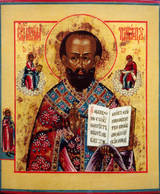Thinking of Santa
23/12/12 05:33
 I didn’t write about St. Nicholas Day this year. Saint Nicholas Day fell on a Thursday this year. December 6 is the traditional day to celebrate the life of Saint Nicholas of Myra, a fourth-century bishop best known as the model for the contemporary traditions of Santa Claus. Not much is known about Nicholas, really. He lived some between 260 and 333. He was bishop of the church in Myra, in the Roman province of Lycia in Asia Minor. He attended the Council of Nicaea in 325 with the other bishops of the Christian empire. At the Council he would have met Emperor Constantine. Those were the days when Christianity was making a radical shift from an obscure religion, whose practitioners were often persecuted to a mainstream religion accepted by people of power and influence. The events of that time changed the face of Christianity forever and speculation abounds about what was lost in the transition.
I didn’t write about St. Nicholas Day this year. Saint Nicholas Day fell on a Thursday this year. December 6 is the traditional day to celebrate the life of Saint Nicholas of Myra, a fourth-century bishop best known as the model for the contemporary traditions of Santa Claus. Not much is known about Nicholas, really. He lived some between 260 and 333. He was bishop of the church in Myra, in the Roman province of Lycia in Asia Minor. He attended the Council of Nicaea in 325 with the other bishops of the Christian empire. At the Council he would have met Emperor Constantine. Those were the days when Christianity was making a radical shift from an obscure religion, whose practitioners were often persecuted to a mainstream religion accepted by people of power and influence. The events of that time changed the face of Christianity forever and speculation abounds about what was lost in the transition.Nicholas probably would have slipped into obscurity as nothing more than a minor saint were it not for a story that circulated about him shortly after his death. He once was known as the patron saint of sailors and I might have encountered him in my reading about boats and sailors, but instead Nicholas is a household name around the world for different reasons. There are several variations on the story, but the general outline is as follows:
There was a citizen of Patara in what is today Turkey, who had once been an important and wealthy man in the city but who had fallen on hard times and into poverty. The man grew so desperate that he lacked sufficient resources to care for his family. In their poverty, the family had few options for the marriages of three daughters because they did not have dowries. Dowries were required in order for young women to marry into the homes of noblemen. In one version of the story, the father is fearful that his daughters will turn to prostitution in order to support themselves.
Nicholas heard the story and decided to do something about it. He bagged up an amount of gold and, in the dead of night, tossed it through the man’s window. The money was used as a dowry for the first daughter. Later Nicholas made a second visit. This time he found the windows latched, so he dropped the bag of gold down the chimney where it fell into the girl’s stocking, which was hung from the mantle to dry. This enabled the second marriage. When Nicholas returned to leave funds for the third daughter, the father was ready. When the bag of gold hit the floor, he leapt from bed and chased down Nicholas. Thus the father found out who the benefactor was. Nicholas, however, made the father swear never to tell anyone what he had done. He did not want praise or recognition for his generosity.
I’m sure that the story has been changed and embellished over the years. One thing stands out. The father must not have kept his promise to Nicholas about not telling, because we all know the story – and the name of the benefactor. Someone told.
The tales of Nicholas are interesting in part because of the way they make him stand out from other saints of the church. There are plenty of saint stories that end in gruesome martyrdoms. Other saint stories tell of miracles – often dramatic healings of hopeless cases. Some tell of courageous confessions of faith.
Nicholas’ story is of a man who apparently had the means to give away large sums of money and who carried out acts of generous charity. I guess the vow of poverty hadn’t quite taken hold for bishops in those days. The fact that Nicholas had the ability to give away enough gold for a daughter’s dowry not just once but three times means that he had access to some serious funds. The traditions surrounding Nicholas tell that he inherited his wealth from his parents and began giving it away only after their deaths. It has been a long time since those days and the stories are well worn. No one is certain of the facts.
Some say that the tradition of a fat Santa Claus date back to the stories of Nicholas. In those days only people of wealth could afford to be fat. In contrast to the types of food eaten by poor people in contemporary America, only wealthy people could afford rich and fat-filled foods in the time of Nicholas. Girth was seen as a sign of success. I’m not sure how much that is a factor in the way that we think of Santa Claus these days. Santa is pictured in different ways in different places. In Europe, you are more likely to see a Santa who is thinner with more squared-off features than our Coca-Cola Santa with his round face, round nose, and round stomach.
 A study published in the British Medical Journal in 2009 suggested that Santa could very well be a “public health pariah.” Nathan Grills of Monash University in Australia found a correlation between countries that recognize Santa and a high rate of childhood obesity.
A study published in the British Medical Journal in 2009 suggested that Santa could very well be a “public health pariah.” Nathan Grills of Monash University in Australia found a correlation between countries that recognize Santa and a high rate of childhood obesity.It is probably a miracle that the old guy is as slim as he is. Think of all of the cookies that are left out for Sana each year. If he has to take a taste of a cookie at each house, no wonder he’s carrying a few extra pounds around the middle. I have plenty of sympathy for the old elf. As I slipped into my ‘50’s I started to exercise a bit less and eat a bit more. The result was a gain in girth. I added a few inches to my waist and my beard turned white. Up on the Cheyenne, the kids took to calling me “Waziya.” I suppose it might be considered an honor to have a Lakota nickname, but it is more of a joke. Waziya is the Lakota name for Santa Claus. The kids were simply describing my appearance.
Some careful dieting and a commitment to exercise have enabled me to enter this holiday season more than 40 pounds lighter than last year and I’ve cut 5 inches off of my belt.
It’s probably a good thing because after being given the blessing of one daughter who had a beautiful wedding, I might find it hard to fund the weddings of the daughters of others. I may have to leave the role of Santa to others.